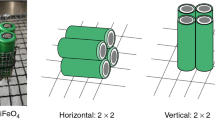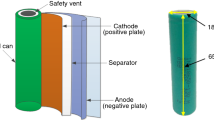Abstract
Safety problem is always a significant consideration before wider field of application such as mobile phones, computers and new energy vehicles. However, the knowledge on the battery combustion behavior is limited. To increase the safety margin, the fire hazard of lithium-ion batteries should be considered. An experimental study of different arrangements: horizontal 4 × 1, horizontal 2 × 2 and vertical 2 × 2 lithium-ion batteries fire behaviors was conducted. The photographs of fire processes and the batteries before and after the fire tests were directly shown to describe the fire hazard. The mass loss rate, heat release rate and heat flux were used to analyze the combustion behavior more detailed. Based on the results, lithium-ion batteries are volatile and burning with potentially deadly explosions. The arrangements can affect the ignition time, heat release rate, released heat and the heat flux, while the way of mass loss and the total mass loss are similar. The results indicate that batteries with bigger heating area have more risky and fierce fires compared with others.







Similar content being viewed by others
References
Thackeray MM, Wolverton C, Isaacs ED. Electrical energy storage for transportation—approaching the limits of, and going beyond, lithium-ion batteries. Energy Environ Sci. 2012;5(7):7854–63.
Balakrishnan PG, Ramesh R, Kumar TP. Safety mechanisms in lithium-ion batteries. J Power Sources. 2006;155(2):401–14.
Lisbona D, Snee T. A review of hazards associated with primary lithium and lithium-ion batteries. Process Saf Environ Prot. 2011;89(6):434–42.
Lithium battery guidance document: transport of lithium metal and lithium ion batteries revised for the 2015 regulations, Rev 1. International Air Transport Association, 2014.
Underwriters Laboratories Inc. UL safety issues for lithium-ion batteries, 2005.
Wen CY, Jhu CY, Wang YW, Chiang CC, Shu CM. Thermal runaway features of 18650 lithium-ion batteries for LiFePO4 cathode material by DSC and VSP2. J Therm Anal Calorim. 2012;109(3):1297–302.
Jhu CY, Wang YW, Wen CY, Chiang CC, Shu CM. Self-reactive rating of thermal runaway hazards on 18650 lithium-ion batteries. J Therm Anal Calorim. 2011;106(1):159–63.
Mandal B, Padhi AK, Shi Z, Chakraborty S, Filler R. Thermal runaway inhibitors for lithium battery electrolytes. J Power Sources. 2006;161:1341–5.
Roth EP, Doughty DH. Thermal abuse performance of high-power 18650 Li-ion cells. J Power Sources. 2004;128:308–18.
Duh YS, Kao CS, Ou WJ, Hsu JM. Thermal instabilities of organic carbonates with charged cathode materials in lithium-ion batteries. J Therm Anal Calorim. 2014;116(3):1105–10.
Mikolajczak C, Kahn M, White K, Long RT. Lithium-ion batteries hazard and use assessment. Berlin: Springer Science and Business Media; 2012.
Webster H. Lithium battery update: full scale fire tests. Washington: Federal Aviation Administration; 2013.
Webster H. Fire protection for the shipment of lithium batteries in aircraft cargo compartments. Washington: Federal Aviation Administration; 2010.
Ribière P, Grugeon S, Morcrette M, Boyanov S, Laruelle S, Marlair G. Investigation on the fire-induced hazards of Li-ion battery cells by fire calorimetry. Energy Environ Sci. 2012;5(1):5271–80.
Fu Y, Lu S, Li K, Liu C, Cheng X, Zhang H. An experimental study on burning behaviors of 18650 lithium ion batteries using a cone calorimeter. J Power Sources. 2015;273:216–22.
Chen M, Zhou D, Chen X, Zhang W, Liu J, Yuen R, Wang J. Investigation on the thermal hazards of 18650 lithium ion batteries by fire calorimeter. J Therm Anal Calorim. 2015;122(2):755–63.
Janssens ML. Measuring rate of heat release by oxygen consumption. Fire Technol. 1991;27(3):234–49.
ISO 5660:1, Reaction to fire tests—heat release, smoke production and mass loss rate—part 1: heat release rate (cone calorimeter method), 2002.
Huggett C. Estimation of rate of heat release by means of oxygen consumption measurements. Fire Mater. 1980;4(2):61–5.
Yao W, Hu XK, Rong JZ, Wang J, Zhang H. Experimental study of large-scale fire behavior under low pressure at high altitude. J Fire Sci. 2013;31:481–93.
Zhang W, Chen X, Chen Q, Ding C, Liu J, Chen M, Wang J. Combustion calorimetry of carbonate electrolytes used in lithium ion batteries. J Fire Sci. 2015;33(1):22–36.
Chen M, Liu J, Lin X, Huang Q, Yuen R, Wang J. Combustion characteristics of primary lithium battery at two altitudes. J Therm Anal Calorim. 2016;124(2):865–70.
Chen M, He Y, Zhou DC, Richard Y, Wang J. Experimental study on the combustion characteristics of primary lithium batteries fire. Fire Technol. 2016;52(2):365–85.
Acknowledgements
This study was supported by the National Natural Science Foundation of China (No. 51376172) and the grant from the Research Grant Council of the Hong Kong Special Administrative Region, China (Contract Grant No. CityU 11301015).
Author information
Authors and Affiliations
Corresponding author
Rights and permissions
About this article
Cite this article
Chen, M., Yuen, R. & Wang, J. An experimental study about the effect of arrangement on the fire behaviors of lithium-ion batteries. J Therm Anal Calorim 129, 181–188 (2017). https://doi.org/10.1007/s10973-017-6158-y
Received:
Accepted:
Published:
Issue Date:
DOI: https://doi.org/10.1007/s10973-017-6158-y




